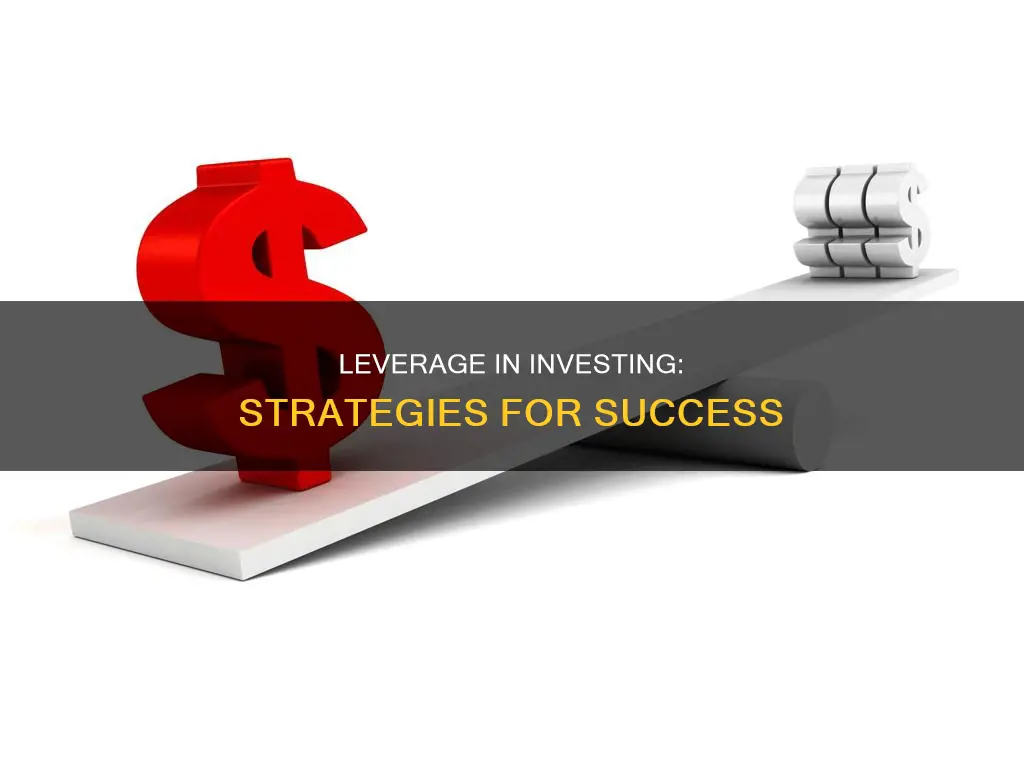
Leverage is a strategy used by investors to increase their buying power in the market. It involves borrowing money to invest in something like a property or a stock, with the goal of magnifying the potential returns. The principle of leveraged investing is that higher investment profits can be realised by using debt facilities. However, leverage is a double-edged sword, as it also amplifies potential losses.
There are different types of leverage, including financial leverage and operating leverage. Financial leverage refers to the use of borrowed money to buy assets or invest in securities. This can be done through margin trading, options trading, and leveraged ETF trading. Margin trading, for example, allows investors to borrow money from a broker to purchase securities, with the account itself serving as collateral for the loan.
Leverage can be a powerful tool in investments, but it carries significant risks. It is important for investors to understand these risks and have a clear investment strategy in place before using leverage.
| Characteristics | Values |
|---|---|
| Purpose | To increase the potential return of an investment |
| Funding source | Borrowed capital |
| Users | Investors, companies, entrepreneurs, professional traders, individuals |
| Risk | Higher risk, greater losses |
| Returns | Higher returns |
| Cost | Interest rates, fees, margin rates, contract premiums |
| Complexity | Requires financial knowledge, time, and portfolio attention |
What You'll Learn

Margin trading
To engage in margin trading, an investor needs to open a margin account with a broker. This account serves as collateral for the loan, and the investor is required to deposit an initial amount, known as the minimum margin, which is typically around $2,000. The broker will then lend the investor money to buy securities, up to a certain percentage of the purchase price, usually 50%. This borrowed money is known as the margin. The investor can use the margin to buy securities and must pay interest on the loan.
For example, if an investor wants to purchase $10,000 worth of securities, they can borrow up to $5,000 from their broker and only need to provide $5,000 of their own capital. The investor then has $10,000 worth of buying power. If the securities increase in value, the investor can sell them, pay off the loan, and keep the remaining profit.
However, margin trading also comes with risks. If the securities decrease in value, the investor may face a margin call, where the broker demands additional funds to cover the losses. If the investor cannot meet the margin call, the broker may forcibly sell the securities, potentially resulting in a loss for the investor. The investor may even end up owing more than their initial investment.
Cash Allocation Strategies: Investing Your Money Wisely
You may want to see also

Options trading
Options are a type of contract that gives the buyer the right to buy or sell a security at a specified price at some point in the future. Options trading can be more complex and riskier than stock trading and often has upfront costs. It requires a good grasp of market trends, the ability to read and interpret data and indicators, and an understanding of volatility.
Options are divided into "call" and "put" contracts. With a call option, the buyer of the contract purchases the right to buy the underlying asset in the future at a preset price, known as the exercise price or strike price. With a put option, the buyer acquires the right to sell the underlying asset in the future at the predetermined price.
Options are essentially leveraged instruments in that they allow traders to amplify the potential upside benefit by using smaller amounts than would otherwise be required if trading the underlying asset itself. For example, instead of laying out $10,000 to buy 100 shares of a $100 stock, you could hypothetically spend $2,000 on a call contract with a strike price 10% higher than the market price.
A standard equity option contract on a stock represents 100 shares of the underlying security. Suppose a trader wants to invest $5,000 in Apple (AAPL), trading at around $165 per share. They can purchase 30 shares for $4,950. Now, let's say a call option on the stock with a strike price of $165 that expires about a month from now costs $5.50 per share or $550 per contract. Given the trader's budget, they can buy nine options for a cost of $4,950. Because the option contract controls 100 shares, the trader is effectively making a deal on 900 shares. If the stock price increases 10% to $181.50 at expiration, the option will expire in the money (ITM) and be worth $16.50 per share (for a $181.50 to $165 strike), or $14,850 on 900 shares. That's a net dollar return of $9,990, or 200% on the capital invested, a much larger return compared to trading the underlying asset directly.
The potential loss from a long call is limited to the premium paid. Potential profit is unlimited because the option payoff will increase with the underlying asset price until expiration, and there is theoretically no limit to how high it can go.
A put option works effectively in the exact opposite direction from the way a call option does, with the put option gaining value as the price of the underlying decreases. Though short-selling also allows a trader to profit from falling prices, the risk with a short position is unlimited because there is theoretically no limit to how high a price can rise. With a put option, if the underlying ends up higher than the strike price, the option will simply expire worthless, and the most you'll lose is the premium paid.
Options can be very useful as a source of leverage and risk hedging. For example, a bullish investor who wishes to invest $1,000 in a company could potentially earn a far greater return by purchasing $1,000 worth of call options on that firm, compared with buying $1,000 of that company’s shares. In this sense, the call options provide the investor with a way to leverage their position by increasing their buying power.
However, options contracts are complex and difficult to price, and so they are often considered a more advanced financial product vehicle, suitable only for experienced investors.
Cash Reserves Investments: A Safe Haven for Your Money
You may want to see also

Leveraged ETFs
A leveraged exchange-traded fund (LETF) is a security that uses financial derivatives and debt to amplify the returns of an underlying index or other assets it tracks. Leveraged ETFs are designed to deliver multiples of the daily performance of a specific index or asset. They are ideal for experienced traders and are suited for short-term (i.e., intraday) trading strategies.
LETFs use derivatives such as futures contracts, forward contracts, total return swaps, and options to magnify the daily returns of the underlying index, stock, or other tracked assets. The extent of the gain depends on the amount of leverage used. For example, an LETF that tracks the S&P 500 would use financial products and debt to magnify each 1% gain in the S&P to a 2% or 3% gain.
The leverage in LETFs can also work in the opposite direction, leading to magnified losses. If the underlying index falls by 1%, the loss is exaggerated by the leverage. This makes LETFs riskier than traditional investments, and they are meant for day-to-day trading rather than long-term investments.
The Securities and Exchange Commission (SEC) first allowed LETFs in 2006, and they have since received tremendous media attention. There are now hundreds of leveraged ETFs, covering various asset classes and industry sectors. The majority are double-leveraged, but there is also a sizeable group of triple-leveraged ETFs.
The Pros and Cons of Leveraged ETFs
Pros:
- LETFs offer the potential for significant gains that exceed the tracked index or assets.
- Investors have a wide variety of securities to trade using LETFs.
- Investors can make money when the market is declining by using inverse LETFs.
Cons:
- LETFs can lead to significant losses that exceed the tracked index or assets.
- LETFs have higher fees and expense ratios compared to traditional ETFs due to premiums, fees, and interest payments on derivatives and margin costs.
- LETFs are not suitable for long-term investments because of the daily rebalancing and the impact of compounding over time.
In summary, leveraged ETFs can provide the potential for higher returns but also come with increased risks and costs. They are designed for short-term trading by experienced investors and are not suitable for a buy-and-hold strategy.
Securities Trading: Part of Investing Cash Flow?
You may want to see also

Borrowing to buy stocks
How It Works
Margin buying involves taking out a loan from a broker to purchase stocks or other financial instruments. The borrowed funds serve as leverage, enabling investors to buy more stocks than they could with their own capital. The idea is that the returns generated by the stocks will exceed the cost of borrowing, resulting in higher profits. This strategy is commonly used by investors seeking to maximise their gains, particularly in short-term, low-risk situations.
Sources of Leverage
Investors can access leverage through various sources, including brokerage margin loans, futures products, and call options. These options differ in terms of interest rates, regulations, and potential risks. For example, margin loans use the investor's existing stocks or other assets as collateral, while futures contracts involve purchasing a financial instrument to buy a specific investment at a later date.
Benefits and Risks
Managing Risk
When using borrowed funds to invest in stocks, it's crucial to carefully manage the associated risks. Investors should monitor their investments closely and consider strategies such as diversifying their portfolio, using stop-loss orders, and maintaining sufficient cash flow to cover interest repayments. It's also essential to have a clear investment plan, conduct thorough research, and only borrow within one's financial capacity to absorb potential losses.
In conclusion, borrowing to buy stocks can be a powerful tool for investors seeking to maximise their returns. However, it's important to approach margin buying with a thorough understanding of the risks involved and a well-defined risk management strategy.
Derivatives in Investment Banking: A Common Practice?
You may want to see also

Borrowing to buy property
A mortgage is a loan taken out to buy a property, with the property itself acting as collateral. This is the most common way to buy a property, as most people do not have the capital to buy a house outright.
Home equity loans are a way to borrow against the equity in your home. This is the difference between the current value of your home and the outstanding balance of your mortgage. For example, if your home is worth $400,000 and you have a mortgage balance of $300,000, you have $100,000 in home equity. You can borrow against this equity to take out a loan or a line of credit, which can be used for various purposes, such as financing home improvements, consolidating debt, or starting a business.
A cash-out refinance is similar to a home equity loan, but it replaces your current mortgage with a new, larger loan. The new loan includes the balance of the existing mortgage plus a portion of the home's equity, withdrawn in cash. This option may allow you to get a lower interest rate on your main mortgage, depending on market conditions.
Leveraging your equity by borrowing against your property can provide significant opportunities for investors, such as the chance to rapidly expand their portfolio. However, it also comes with considerable risks. Borrowing against borrowed money exposes an investor to the possibility of significant losses as well as profits. The success of this strategy relies heavily on the market and a well-executed plan.
It is important to carefully consider your financial situation and conduct thorough research before deciding to borrow money to buy property.
How Investments Can Drain Your Cash Reserves
You may want to see also
Frequently asked questions
Leverage is the strategy of using borrowed money to increase investment power. An investor borrows money to make an investment, and the investment’s gains are used to pay back the loan.
Leverage increases the potential returns on an investment. For example, if you have $100 of your own money and borrow $1,500 from the bank at an interest rate of 6%, you can invest the entire $1,600 in an investment that you are confident will grow 15% in a year. You plan to return the borrowed money plus interest at the end of a year. The value of the investment will be $1,840 at the end of the year. You will pay the bank back $1,590. That leaves you with a total of $250 and a net gain of $150 once you subtract the initial $100 you invested. That’s a 150% return!
While leveraging offers several benefits, it also comes with significant risks. If the investment goes south, you lose more money because you have to repay the loan on top of your own investment. For example, if you lose 15% on your $1,600 investment, you are left with $1,360. You still have to pay back the bank $1,590. That means you owe $230 more than the $1,360 you have. Based on your $100 initial investment, you lost 330%.







